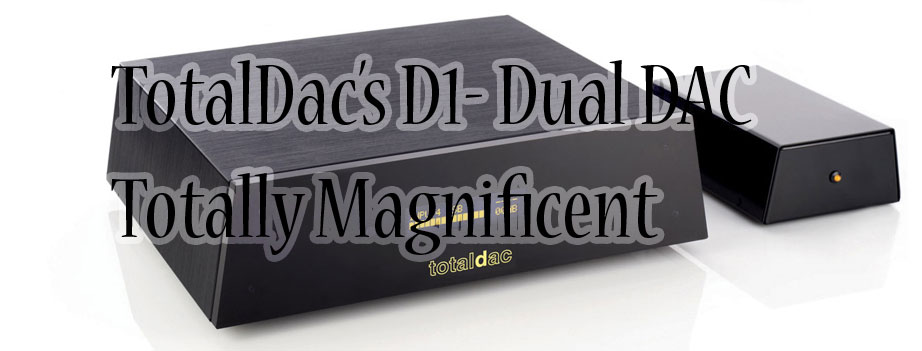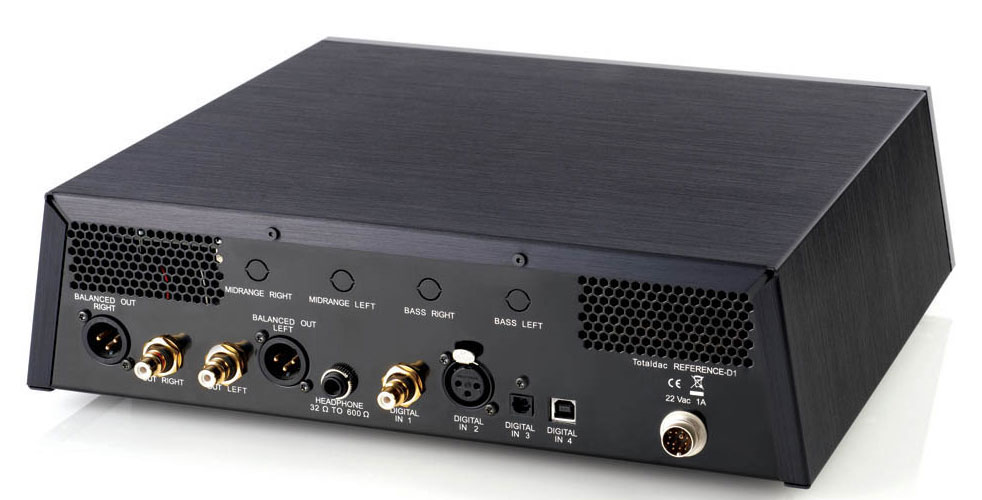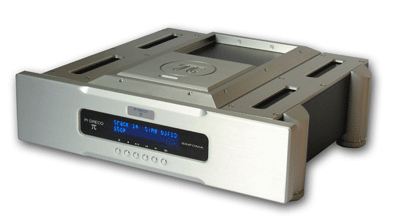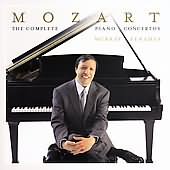TotalDac D1- Dual DAC

 I first met Vincent Brient, founder and designer of popular French audio company TotalDAC at Munich High End 2013 audio show. The Munich High End is among my favorites because it’s where I get to see and hear products not easily found anywhere else in the world. Brient showcased his products in nicely decorated room that featured his products alongside European designers Engstrom & Engstrom, Kaiser and Bibacord. Overall, I was greatly impressed by open, dynamic ease of this setup. The name TotalDAC alone was very intriguing. I had a nice long conversation with Brient shortly thereafter, and I requested a chance to review the TotalDAC D1 tube DAC and he told me I should review the D1-Dual DAC since I have a true balanced system.
I first met Vincent Brient, founder and designer of popular French audio company TotalDAC at Munich High End 2013 audio show. The Munich High End is among my favorites because it’s where I get to see and hear products not easily found anywhere else in the world. Brient showcased his products in nicely decorated room that featured his products alongside European designers Engstrom & Engstrom, Kaiser and Bibacord. Overall, I was greatly impressed by open, dynamic ease of this setup. The name TotalDAC alone was very intriguing. I had a nice long conversation with Brient shortly thereafter, and I requested a chance to review the TotalDAC D1 tube DAC and he told me I should review the D1-Dual DAC since I have a true balanced system.
TotalDAC is a small French company Brient started four years ago. Brient, like many other talented audio designers, began as an engineering college student (attended Supelec). During his studies most of his research projects were based on a digital active crossovers. He developed a knack for digital audio even before working as an engineer in the design of electronic boards in television, in smart-phones, and GPS/MP3’s for the blind. To date Brient has obtained several patents for his designs. Brient also worked with and was taught by his mentor John Westlake: the guy behind such well-known products like Pink Triangle’s DaCapo D/A converter, Audiolab’s M-DAC and Cambridge Audio’s DACMagic. He became expert in audio measurement and listening tests on different types of loudspeakers and amplifiers (SET, OTL, Class A, Class AB solid-state and Class D). A self-ordained music lover and audiophile, Brient needed a good DAC at a price he could afford. But, unfortunately, (or fortunately in his case), he wasn’t able to find one. Almost immediately, Brient started designing and building his own. He tried most of the DAC technologies and many different DAC chips and, after many hours of rigorous research and development, he came up with a DAC that really satisfied him. When he finished the final version his audiophile friends liked it so much that they asked Brient to build DACs for them. It was on that day that TotalDAC was born.
The TotalDac D1- Dual DAC does not use commercial DAC chips (Most DACs on the market use a Delta-Sigma DAC chip). Instead it utilizes a discrete R2R ladder DAC like respected companies MSB, Thrax Audio, and Light Harmonic. The D1-Dual DAC boasts 200 Vishay 0.01% VAR Bulk Metal Foil resistors per stereo channel (100 per DAC). Brient also states his products employs only the best sounding components regardless of cost and employs no integrated circuits. Instead he chose use his own exclusive technologies. The D1-Dual DAC is a (NOS) non-oversampling DAC. However, there is a non-oversampling DAC compensation filter which can only be activated or deactivated by remote control. The D1-Dual DAC utilizes a FPGA (Field Programmable Gate Array), like MSB, Chord and Playback Designs. Brient’s design differs ever so slightly he claims because he uses a special buffer memory (FIFO) to store about 10ms of incoming data and relocking to reduce jitter. For more technical information please refer to TotalDAC’s website. As its name suggests it’s a true fully balanced design with one a dual DACs per channel.
The D1-Dual DAC is a single chassis design but does come with an external power supply. The D1-Dual DAC comes in an optional black or silver aluminum faceplate (mine came in silver). The front panel of the DAC features a simple layout, a metal chassis with an acrylic center panel, with an LED display. I find it simple, unique and appealing to these eyes. These are no controls on the front panel; all functions must be controlled remotely. The remote control allows you to adjust for volume, source, and activate the non-oversampling compensation filter on/off. I found extra nice feature also: a phase controller! I could actually control the phase via this smartly designed remote from my listening seat. In a system with only digital sources, you can use the D1-Dual DAC as a preamplifier it also sports a digital volume control.

On the back, the Dual DAC comes with a host of digital inputs including 192kHz asynchronous Xmos USB, two S/PDIF inputs (Coax and Toslink), and an AES/EBU input, all selectable from the remote control. All inputs support up to 24/192 playback, 16 to 24 bit formats, except 96kHz max for optical input. A DSD (DoP) option is also now available. Lastly, the TotalDAC comes equipped with an analogue headphone output jack (32 Ohm-600 Ohm – 3.1 Vrms max via RCA or 6.2Vrms max via XLR).
The TotalDAC D1-Dual DAC arrived in one double-boxed corrugated carton. Getting out of its double corrugated box was a breeze, as it weighs only 14.3 lbs along with a small robust power supply. Since these products do not come with captive AC cords, I chose to use my reference Jorma Design Unity AC cord and a set of ASI topline feet to assure a stable platform.
 I used my reference Pi Greco Symphonia CD player (right) solely as a transport to drive the D1-Dual DAC. Usually, whenever I put a new product in my equipment rack I never listen too critically for the first couple of weeks. But the first track played from my Sinfonia sounded so good that I turned up the volume and played music throughout the night. The D1-Dual DAC appeared ready for serious business right out of the box. I could immediately hear its highly transparent yet natural character. If the D1-Dual DAC sounded this good immediately, what was it going to sound like after burn-in?
I used my reference Pi Greco Symphonia CD player (right) solely as a transport to drive the D1-Dual DAC. Usually, whenever I put a new product in my equipment rack I never listen too critically for the first couple of weeks. But the first track played from my Sinfonia sounded so good that I turned up the volume and played music throughout the night. The D1-Dual DAC appeared ready for serious business right out of the box. I could immediately hear its highly transparent yet natural character. If the D1-Dual DAC sounded this good immediately, what was it going to sound like after burn-in?
My Sinfonia CD player is a lovely sounding one-box performer that dethroned my previous long-term reference, the AMR CD77. However, as good as the Sinfonia CD player performs, listening to the TotalDAC D1-Dual DAC offered more than a touch of transparency, speed and inner detail, while sounding ever more freer of digital artifacts. Everything I played through the D1-Dual DAC sounded absolutely fabulous. The D1-Dual DAC’s overall sound was as non-digital, transparent and as high in resolution as I’ve experienced. It was as if I was able to look directly into the recording studio’s window. Its ability to turn music reproduction into an appealing and engaging musical experience proved breathtaking.
 Listening to Mozart’s Piano Concerto, N0.9 in E flat Major, K (Sony 82876872302), played and conducted by Murray Perahia, the beautiful second movement, the Andantino, proved stunning through the D1-Dual DAC. It rendered the piano and the orchestra masterfully as it fleshed out layers of details and subtle nuances. The D1-Dual DAC was able to illuminate piano better with an ideal balance between the hammer attack and the decay I had not quite experienced from a digital source and the spaciousness of the orchestra added a new measure of depth to this recording.
Listening to Mozart’s Piano Concerto, N0.9 in E flat Major, K (Sony 82876872302), played and conducted by Murray Perahia, the beautiful second movement, the Andantino, proved stunning through the D1-Dual DAC. It rendered the piano and the orchestra masterfully as it fleshed out layers of details and subtle nuances. The D1-Dual DAC was able to illuminate piano better with an ideal balance between the hammer attack and the decay I had not quite experienced from a digital source and the spaciousness of the orchestra added a new measure of depth to this recording.
The D1-Dual DAC effect on my system’s spatial performanceis as three-dimensional and spacious as I’ve experienced with digital. The D1-Dual DAC allowed the system to throw a huge space between and behind the Conspiracy loudspeakers making them vanish easily. But the real magic was in the details. The low-level ambience cues that locate and describe a hall’s boundaries and space between performers. With the D1-Dual DAC, the performers, the stage, the ambience, were more distinctly more alive and there. The tiniest of musical nuances were, for the first time, in greater expression. Certain aspects of the orchestra came forward just a tad, which gave my room a greater sense of depth. This added to the impression that I was sitting before a live recording rather than a canned reproduction. Its portrayal of individual instruments was extraordinary, again revealing layers of detail and nuance that I’d not previously heard in my system.
I must say the cello has to be one of my favorite instruments. The D1-Dual DAC’s transparency to the source also paid hefty dividends in the reproduction of proper tonal shadings. Instrumental timbres sounded natural and realistic rather than sounding overlaid and one dimensional. Listening to solo performers like cellist Martin Zellar playing J.S. Bach’s Suite 1 in G for Cello (M073A). This superbly recorded MA disc sounds grand with the added dimensionality the D1-Dual DAC revealed.
The D1-Dual DAC’s digital volume control worked beautifully; it was open, detailed and very transparent. In a digital only source system TotalDAC uses as a preamplifier that works flawlessly and simplifies the system with fewer cables and boxes. On its own, D1-Dual DAC can handle high volume levels effortlessly. But, of course, whether or not one needs a preamplifier depends on their source components and personal preference. I could easily live with The D1-Dual DAC as a standalone preamplifier.
I don’t have firsthand experience of all other super DACs out there but the Totaldac D1-Dual DAC is the best sounding digital playback I’ve had in my home. It produced a transparent, delicate, and musically involving sound filled with life. Yes, at $12,300, its not inexpensive but for what it offers, it’s very reasonable and, better yet, TotalDAC does offer a 10-day-in-home trial period so you can test drive their DACs before you commit to purchase. Most highly recommended!


Features:
-192KHz asynchronous Xmos USB, optical, RCA and AES-EBU digital inputs, selected from a remote control.
-44.1KHz, 48KHz, 88.2KHz, 96KHz, 176.4KHz and 192KHz, 16 to 24 bit formats supported on all inputs except 96KHz max for optical input.
-as an option, DSD (DoP standard) supported on the USB, AES-EBU and spdif inputs.
–USB input compatible with Jplay in 24 bit “extreme hibernate” mode.
-embedded custom clock with anti-jitter FIFO memory.
-3.1Vrms max RCA, 6.2Vrms max XLR analog output and 32ohm-600ohm 3.1Vrms max headphone amplifier.
-all unused inputs are completely disconnected (including the ground) to keep the optimum noise floor even when several sources are connected.
-Class A discrete transistor output stage for the d1-dual DAC.
-power consumption 21W.
-DAC dimensions: height 110mm, width 360mm, depth 290mm.
-power supply dimensions: height 65mm, width 122mm, depth 180mm.
-weight: 6.5kg.
Website: www.totaldac.com
Stereo Times Masthead
Publisher/Founder
Clement Perry
Editor
Dave Thomas
Senior Editors
Frank Alles, Mike Girardi, Russell Lichter, Terry London, Moreno Mitchell, Paul Szabady, Bill Wells, Mike Wright, and Stephen Yan,
Current Contributors
David Abramson, Tim Barrall, Dave Allison, Ron Cook, Lewis Dardick, John Hoffman, Dan Secula, Don Shaulis, Greg Simmons, Eric Teh, Greg Voth, Richard Willie, Ed Van Winkle, Rob Dockery, Richard Doran, and Daveed Turek
Site Management Clement Perry
Ad Designer: Martin Perry





Be the first to comment on: TotalDac D1- Dual DAC